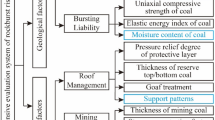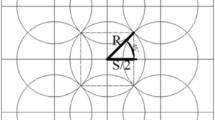Abstract
The occurrence of coal bursts affects the safety of coal mines while coal burst hazard evaluation exerts a guiding influence preventing future coal bursts. Therefore, a method for quantitatively evaluating coal burst hazard was proposed based on zone division and an analytic hierarchy process (AHP). On this basis, by considering the distribution of influence factors of coal bursts in coal mining face (CMF) and means of influencing weight changes, the research aimed to enhance the accuracy and pertinence of coal burst hazard evaluation. By investigating the LW250204 of Yanbei Coal Mine in Gansu Province, China, it can be speculated that the CMF was influenced by various factors (including extra-thick coal seam, syncline and anticline tectonics, mining- induced disturbance, dip angle of coal seams, and mining depth) and thus suffered significant threat of coal burst. The results revealed the following three points: firstly, the degree of coal burst hazard had a positive correlation with the thickness of the coal seams, the mining depth, and mining-induced disturbance, while it exhibited a negative correlation with syncline and anticline tectonics. Moreover, it showed a parabolic correlation with the dip angle of the coal seams. Secondly, the zone division of the CMF was carried out according to the range of influence and changes in various factors. Based on AHP and the degree of influence of different factors on coal burst hazard, an evaluation matrix for the weights of influence factors driving coal bursts was established to quantify the differences between weights of various influence factors. Thirdly, based on the evaluation matrix for weights of influence factors, the relative coal burst hazard index was constructed to quantify the coal burst hazard in a given zone. Through testing, the goodness of fit between the distribution of the global relative coal burst hazard indices of the LW250204 and mininginduced tremors (MITs), as located, reached 90.8%, which validated the accuracy of the evaluation results. The research can provide a reference for quantitative evaluation of coal burst hazard in coal mines.
Similar content being viewed by others
References
Benioff, H., 1951, Crustal strain characteristics derived from earthquake sequences. Colloquium on Plastic Flow and Deformation within the Earth, Hershey, Sep. 12–14, Transactions of the American Geophysical Union, 32, p. 508–514.
Bukowska, M., 2006, The probability of rockburst occurrence in the Upper Silesian Coal Basin area dependent on natural mining conditions. Journal of Mining Science, 42, 570–577.
Cao, A.Y., Dou, L.M., Wang, C.B., Yao, X.X., Dong, J.Y., and Gu, Y., 2016, Microseismic precursory characteristics of rock burst hazard in mining areas near a large residual coal pillar: a case study from Xuzhuang Coal Mine, Xuzhou, China. Rock Mechanics and Rock Engineering, 49, 4407–4422.
Dou, L. and He, X., 2013, Technique of classification forecasting rock burst in coal mines. Journal of China University of Mining and Technology, 36, 717–722.
Gu, S.T., Wang, C.Q., Jiang, B.Y., Tan, Y.L., and Li, N.N., 2012, Field test of rock burst danger based on drilling pulverized coal parameters. Disaster Advances, 5, 237–240.
Kracke, D.W. and Heinrich, R., 2004, Local seismic hazard assessment in areas of weak to moderate seismicity–case study from eastern Germany. Tectonophysics, 390, 45–55.
Ji, M., Guo, H.J., Zhang, Y.D., Li, T., and Gao, L.S, 2015, Hierarchic analysis method to evaluate rock burst risk. Mathematical Problems in Engineering, 2015, 1–8.
Jin, P.J., Wang, E.Y., Huang, N., and Wang, S.H., 2013, Catastrophe progression method on forecast of rock burst. Disaster Advances, 6, 34–38.
Li, J., Yue, J., Yang, Y., Zhan, X., and Zhao, L., 2017, Multi-resolution feature fusion model for coal rock burst hazard recognition based on acoustic emission data. Measurement, 100, 329–336.
Li, N. and Jimenez, R., 2018, A logistic regression classifier for longterm probabilistic prediction of rock burst hazard. Natural Hazards, 90, 197–215.
Li, H., Zhou, H., Jiang, Y., and Wang, H., 2016, An evaluation method for the bursting characteristics of coal under the effect of loading rate. Rock Mechanics and Rock Engineering, 49, 3281–3291.
Li, X., Wang, E., Li, Z., Liu, Z., Song, D., and Qiu, L., 2016, Rock burst monitoring by integrated microseismic and electromagnetic radiation methods. Rock Mechanics and Rock Engineering, 49, 4393–4406.
Li, Z., Zhu, L., Yin, W., and Song, Y., 2015, Study on monitoring rock burst through drill pipe torque. Shock and Vibration, 2015, 1–8.
Liu, G.J., Lu, C.P., Wang, H.Y., Liu, P.F., and Liu, Y., 2015, Warning method of coal bursting failure danger by electromagnetic radiation. Shock and Vibration, 2015, 1–9.
Patynska, R., 2013, The consequences of rock burst hazard for silesian companies in Poland. Acta Geodynamica et Geomaterialia, 10, 227–235.
Saaty, T.L., 1977, A scaling method for priorities in hierarchical structures. Journal of Mathematical Psychology, 15, 234–281.
Wang, C., Cao, A., Zhu, G., Jing, G., Li, J., and Chen, T., 2017, Mechanism of rock burst induced by fault slip in an island coal panel and hazard assessment using seismic tomography: a case study from Xuzhang colliery, Xuzhou, China. Geosciences Journal, 21, 469–481.
Wang, S., Li, C., Yan, W., Zou, Z., and Chen, W., 2017, Multiple indicators prediction method of rock burst based on microseismic monitoring technology. Arabian Journal of Geosciences, 10, 132. https:// doi.org/10.1007/s12517-017-2946-8
Wen, Z., Wang, X., Chen, L., Lin, G., and Zhang, H., 2017, Size effect on acoustic emission characteristics of coal-rock damage evolution. Advances in Materials Science and Engineering, 2017, 1–8.
Yu, Z., Jiang, F., Zhu, Q., and Li, J., 2014, Research on multivariate hierarchical analysis and evaluation on rock burst hazard. Progress in Mine Safety Science and Engineering II, 467–476.
Zhang, C., Canbulat, I., Hebblewhite, B., and Ward, C.R., 2017, Assessing coal burst phenomena in mining and insights into directions for future research. International Journal of Coal Geology, 179, 28–44.
Zhang, Z.Z., Gao, F., and Shang, X.J., 2011, An improved comprehensive index method for the evaluation of rock burst risk in mining. Advanced Materials Research, 301, 1389–1394.
Acknowledgments
The work is supported by the Fundamental Research Funds for the Central Universities (2017XKQY046) and the Project of PADD funded by the Priority Academic Programme Development of Jiangsu Higher Education Instruction (SZBF2011-6-B35).
Author information
Authors and Affiliations
Corresponding author
Additional information
Publisher’s Note Springer Nature remains neutral with regard to jurisdictional claims in published maps and institutional affiliations.
Rights and permissions
About this article
Cite this article
Chen, F., Cao, A., Dou, L. et al. A quantitative evaluation method of coal burst hazard based on zone division and an analytic hierarchy process: a case study on Yanbei coal mine, Gansu Province, China. Geosci J 23, 833–848 (2019). https://doi.org/10.1007/s12303-018-0081-5
Received:
Accepted:
Published:
Issue Date:
DOI: https://doi.org/10.1007/s12303-018-0081-5




